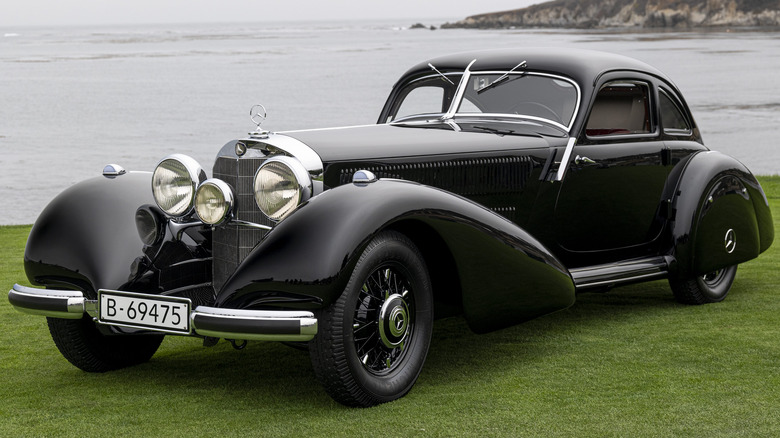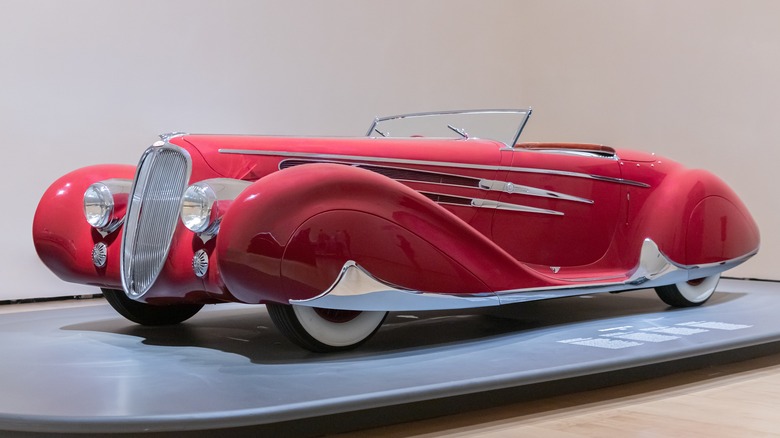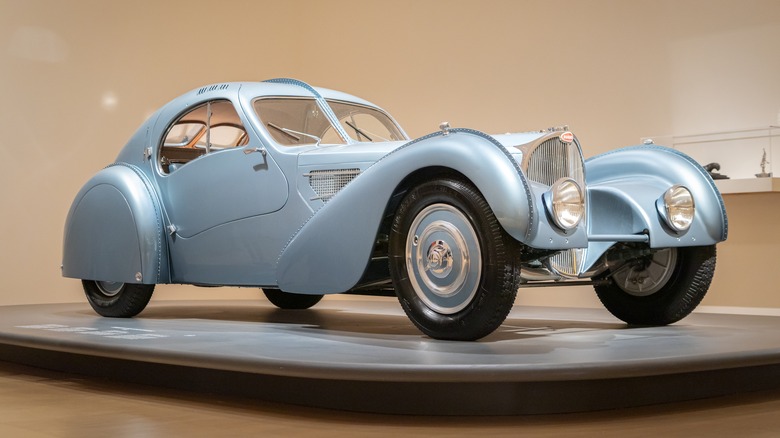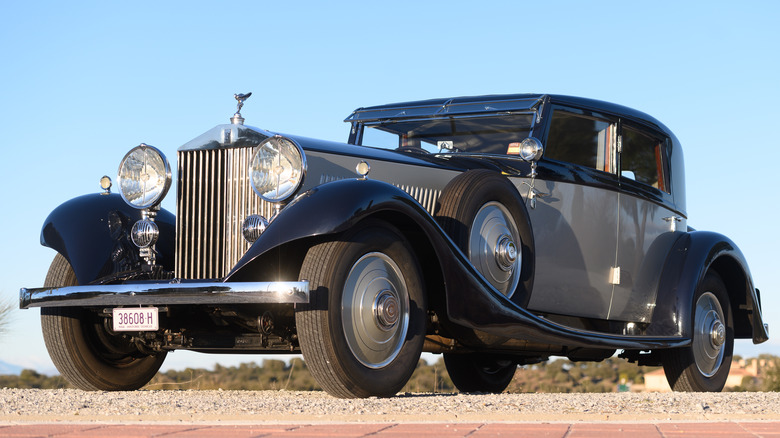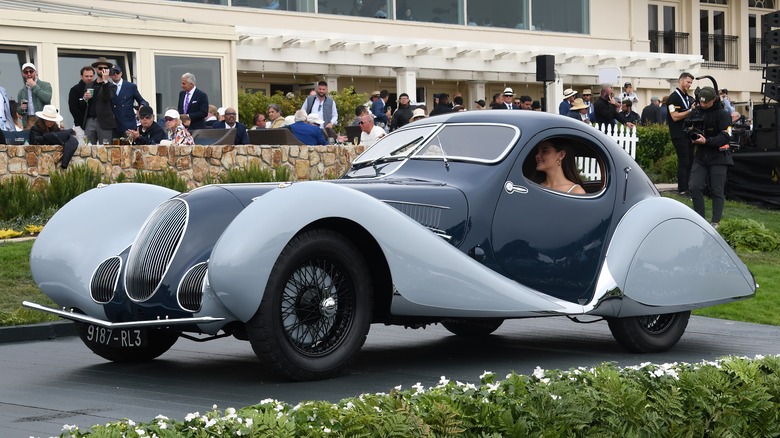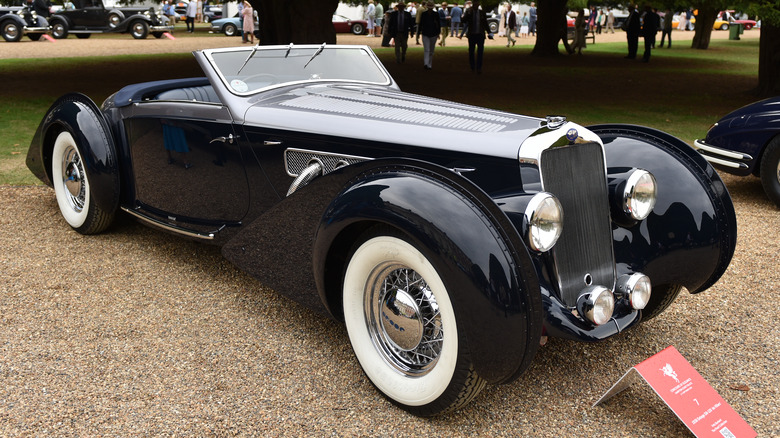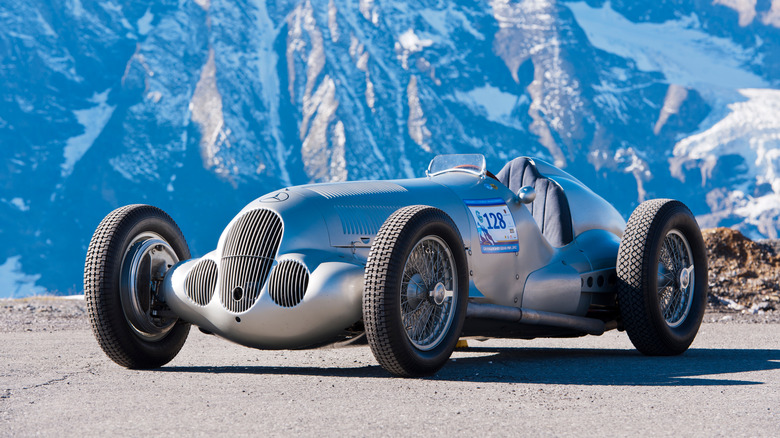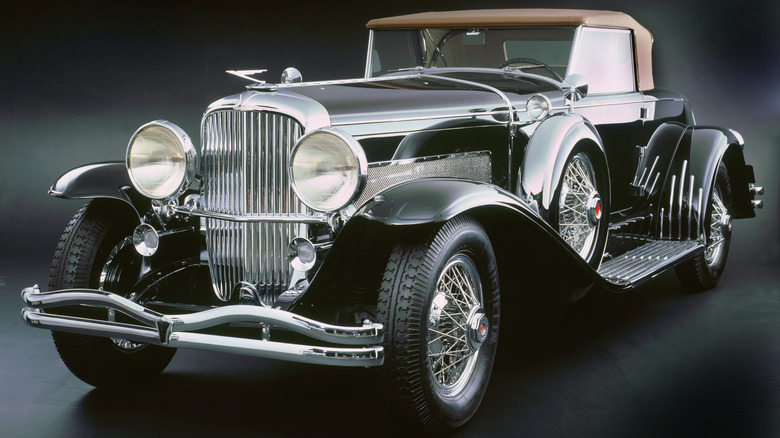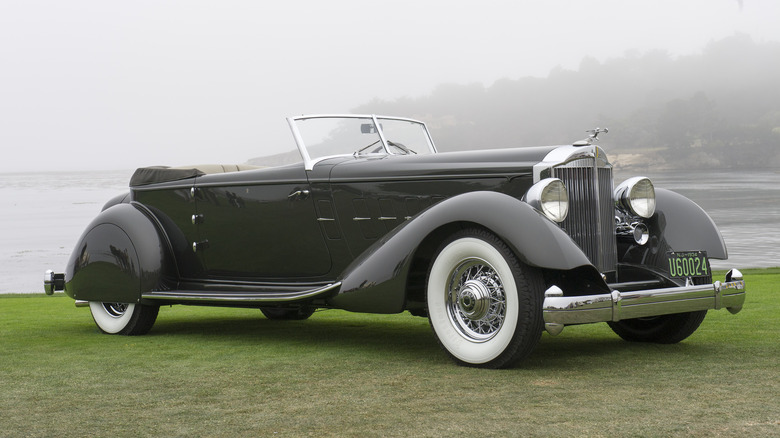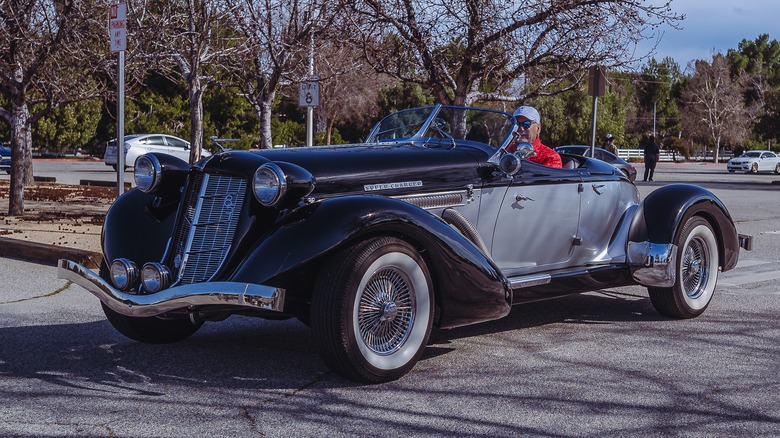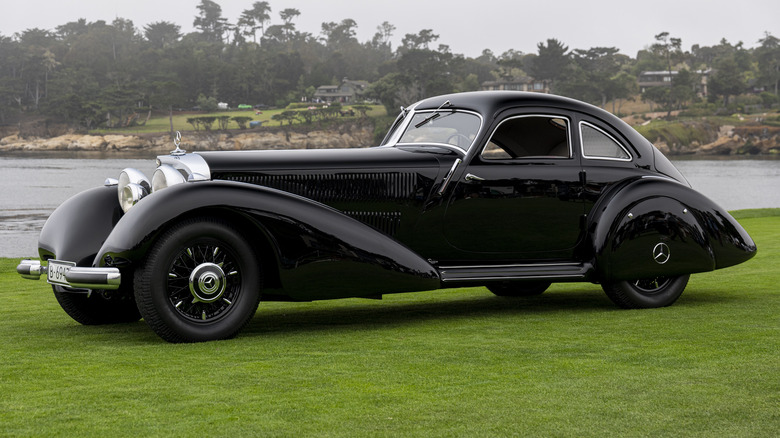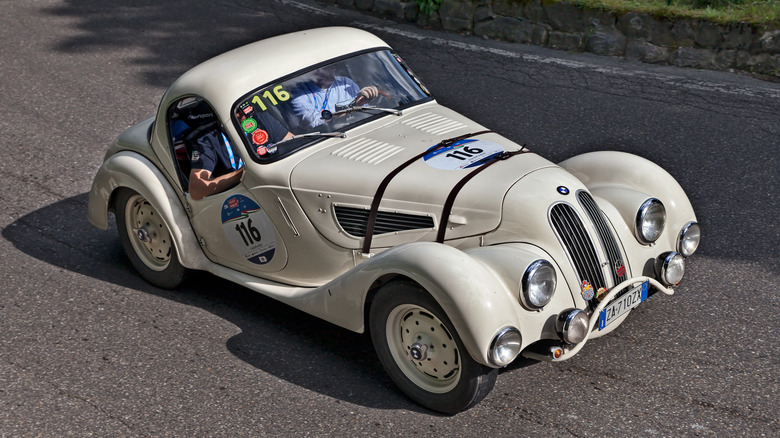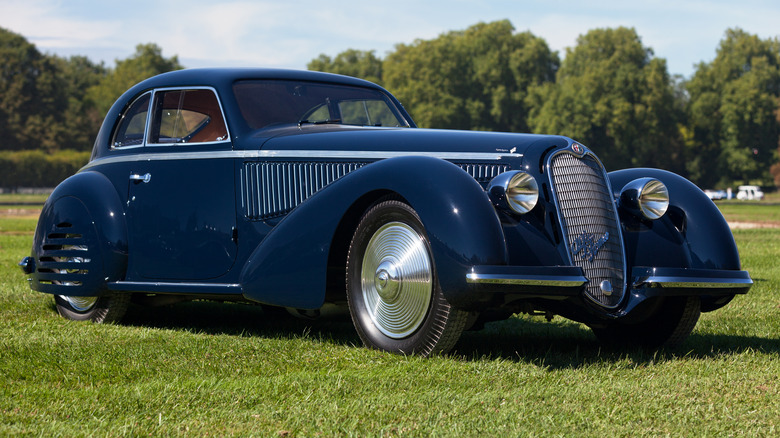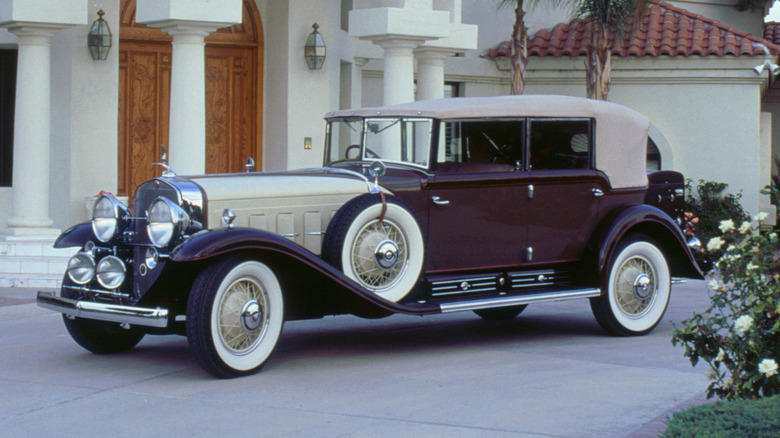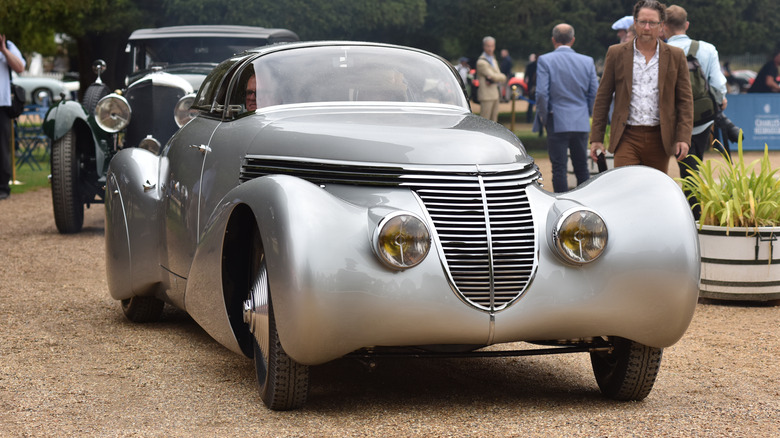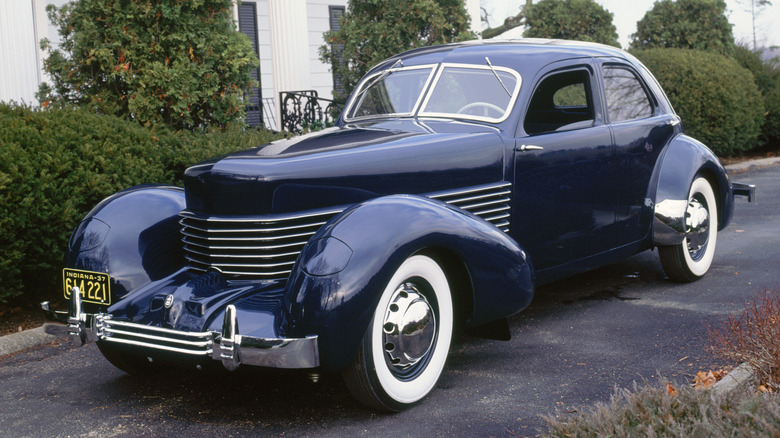15 Of The Most Beautiful Pre-War Cars Ever Built
The '30s were a unique time for automotive manufacturing. The world was reeling from the impact of the Great Depression, but a new wave of wealthy individuals wanted to make a statement with that most fashionable of technological advancements — the motor car.
The functional design trends of the '20s were no longer enough and the turn of the decade gave way to grander, more avant-garde designs inspired by everything from art to architecture. This encompassed not only the finest luxury cars of England and America but the exotic, unusual vehicles being produced by French automakers and the boundary-pushing performance cars emerging from Germany.
This period of styling innovation was put to an abrupt halt with the breakout of World War II, which forced many manufacturers to cease passenger car production altogether and severely hampered the output of others. It would take many years for the car industry to recover after peace was restored, but the cars of the '30s have remained of particular fascination to the world's wealthiest and most influential collectors. Here are 15 of the best designs from this golden era.
Delahaye Type 165
Named after its founder Emile Delahaye, the French carmaker Delahaye had been in business since the turn of the century but saw its profile grow exponentially in the mid-'30s after the release of the Type 135. The car established itself as both a premier racing machine and a highly desirable luxury car. After its many triumphs in competition, Delahaye developed a successor, the Type 145. The luxury variant of the Type 145 was christened the Type 165, which in its most famous form was bodied by Figoni & Falaschi. Only a handful of examples were made, the most desirable of which features a V12 engine derived from the racing Type 145.
A Type 165 was shown off at the New York World Fair in 1939, being billed as part of "The World of Tomorrow." However, with war looming in Europe, that tomorrow turned out to be a world away from what Delahaye had envisioned. The company did survive the war but, like many other luxury car manufacturers, struggled to find enough willing buyers in the years after. It was eventually bought out in 1954 after several failed attempts at revival and stopped producing passenger cars a year later.
That left the Type 165 as one of the last products of its heyday — a representation of a future that never was.
Bugatti Type 57 SC Atlantic
As well as being one of the most valuable cars in the world, the Bugatti Type 57 SC Atlantic is also the source of one of automotive history's greatest mysteries. Four examples of the car were built, but only three survive to the present day, each of which is known by the surnames of their original owners. The Rothschild Atlantic was delivered to Victor Rothschild, a member of the well-known Rothschild family, while the Holzschuh Atlantic was delivered to Frenchman Jacques Holzschuh. The fourth and final Atlantic to be produced was the Pope Atlantic, which was first sold to an R.B. Pope and is now owned by clothing magnate Ralph Lauren.
However, the second Atlantic produced was retained by Jean Bugatti, son of Ettore, for use as a personal car. During the war, Bugatti moved his factory equipment and remaining inventory by train to a safer location across France that was further away from the fighting, but the Atlantic never arrived. It's not known where it went –- it was reported to be on the train and then seemingly just vanished.
Theories as to what happened have so far proved inconclusive, but there are two that seem to be most plausible. One claims that the car was stashed away in the new factory and eventually destroyed when it was bombed later during the war. However, the other says Ettore Bugatti stored it in a secret location which, to date, has still never been found.
Rolls-Royce Phantom II
Unveiled in 1929 as the replacement to the original Phantom, the Phantom II featured iterative mechanical improvements well as styling tweaks by its coachbuilders. Throughout the '20s, a number of noteworthy competitors emerged from the likes of Daimler and Lanchester, and so Henry Royce designed the car specifically to reassert the company's place at the head of the luxury car field. That meant a revised version of the 7.7L six-cylinder engine producing 122 horsepower was standard, and a redesigned chassis allowed the car to sit lower than before, setting it apart visually from the competition.
Just under 1,700 examples of the car were made over the course of production, with various approved coachbuilders providing individually designed bodywork to the specifications of each owner. A higher-performance Continental variant was also produced, with an estimated 281 examples leaving the factory. Many consider the Phantom II to be the best-looking of the pre-war Rolls-Royces, with the Phantom III delivering an upgraded engine and more technological complexity but a slightly less timeless silhouette than its predecessor.
Talbot-Lago T150-C SS Teardrop Coupe
After being rescued from bankruptcy by Anthony Lago in the mid-'30s, Talbot would mark its triumphant comeback with the T150-C, a racing version of the brand's proven T150 engine. The car was redesigned for improved performance, but to really show off the engine, Lago decided a head-turning bodyshell was needed. He formed a partnership with coachbuilders Figoni & Falaschi of Paris, who would go on to design another entry on this list, the Delahaye Type 165.
The finished Talbot-Lago drew heavy inspiration from the Art Deco style that was prevalent at the time, with swooping lines and a shape that came to be known as the Teardrop Coupe. A total of 16 examples were constructed, each one slightly different from the next to accommodate the wishes of the individual owners. Although the Teardrop Coupe was primarily designed as a luxurious road car, one owner decided to make full use of its racing engine and entered it into the 1939 24 Hours of Le Mans.
The T150-C may have seen more competition use were it not for the breakout of war just a few short weeks after the race concluded, which threatened the survival of the freshly resurrected Talbot-Lago. The company did resume operation after the war but never managed to construct anything as jaw-dropping (or as valuable to collectors) as the Teardrop Coupe.
Delage D8-120
The long-running Delage D8 received an upgrade in 1937 with a new chassis similar to the one being produced by Delahaye, which was not that surprising considering that the two had merged just over a year prior. A new gearbox and revised brakes were also fitted, with the resulting car christened the D8-120. As was convention at the time, a selection of coachbuilders provided bodies with the car, with no two examples exactly the same. Many of the most sought-after versions combined the latest in aerodynamics knowledge with the flair of Art Deco, giving the car a top speed of just under 100 mph without compromising on looks.
Their rarity and status as one of the leading French luxury cars has kept them high on the wishlist for collectors, although prices haven't seen the same huge increases as other French rarities from the era like the Talbot-Lago Teardrop Coupe. Nonetheless, they remain an order of magnitude out of reach for most car collectors, with a 1937 example selling for $770,000 at auction in 2013.
It's tricky to establish a set model value for cars like this since condition and history play a huge part. Beyond that, many sales of pre-war cars are private, and therefore no data is available on the selling price. However, it's safe to say that interest in the D8-120 is unlikely to wane anytime soon, and so owners can be almost sure of a safe return on their investment.
Mercedes-Benz W125
One of the most formidable Grand Prix cars in history, the W125 delivered around 600 horsepower and could reach speeds above 200 mph. Unlike the other cars here, it was designed purely for racing, with no customer version available, although one example is known to now be in private hands. It was unveiled in 1937 and could only race for a single year before new regulations forced Mercedes to develop a successor, the W154. It is, to many, the ultimate pre-war race car, and its streamlined appearance has become instantly recognizable to fans of the sport.
It might not boast the art deco flair of a Delahaye or the imposing pomp of a Rolls-Royce, but its design was arguably just as influential as either of them. Its looks epitomized the brutal power contained underneath the hood, and such is its status that many consider it to be an essentially priceless car. The sole known car in private ownership was listed for sale at a UK-based specialist dealer a few years ago but sold for an undisclosed sum to an unknown collector.
Duesenberg SJ
The Duesenberg SJ was the supercharged version of the Model J and has something of confusing history. Although Duesenberg built 38 superchargers in total, some were swapped between different chassis, and several factory SJs had superchargers removed in the years after they were originally sold. So, it's not out of the question to find a non-supercharged SJ, despite the entire point of the model being the fitting of a supercharger.
While its provenance might be confusing, its grand looks are much less debatable. The SJ summed up all the best aspects of American car design at the time, with a selection of noteworthy coachbuilders available to choose from for discerning buyers.
Each one varied slightly from the other, and it's impossible to single out a certain chassis as being definitely better looking than the next, but all of them conveyed a level of importance and refinement that even today's best luxury cars struggle to match. Many surviving examples now have interesting backstories to further add to their appeal, too. For instance, one example sold at RM Sotheby's in 2015 was even used as a taxi in Chicago for a brief period after being originally built for the heiress to the Mars candy empire.
Packard Twelve Dietrich Convertible Victoria
For the most discerning customers who thought a "regular" Packard Twelve wasn't special enough, the marque offered Dietrich Individual Customs which were both significantly pricier and significantly more impressive in power and styling. A V12 engine with 160 horsepower sat under the hood, but it was the custom coachwork and luxurious interior that really made the car stand out from the rest. As one of the most sought-after American classics, most examples of the car have remained in the United States, although they're rarely listed for public sale.
Every so often, a Dietrich Convertible Victoria appears at a concours, usually bagging an award or two in the process, but that's about the only way for enthusiasts to see one in the flesh. That is, unless they have the means to purchase one, but doing that will require very deep pockets indeed — an example put up for sale in 2015 fetched $4,130,000, making it one of the most expensive American cars of its kind.
Auburn 851 SC Boattail Speedster
Not only was the Auburn Boattail Speedster one of the best-looking cars of its era — it was also one of the fastest. The supercharged version of the car was unveiled in 1935 and broke an astonishing 70 different speed records at Bonneville Salt Flats that year, in stock form no less. The boattail styling of the car had been the preserve of the most high-end coachbuilders in previous years, but the Boattail Speedster brought the design to a production car for the first time. It was still a very limited production car, though, as just 150 examples a year are thought to have been produced.
It reportedly wasn't easy to drive either, but its appeal was as a halo product with unique styling and class-leading performance. Every car was certified to reach at least 100 mph and came with a plaque proclaiming so. Like most high-end cars of the era, the Boattail Speedster commands significant sums today. In fact, most of the priciest examples will have additionally had hundreds of thousands of dollars of restoration work completed to keep them pristine over the decades.
Mercedes-Benz 540K Autobahn Kurier
Few cars, if any, could compete with the Mercedes-Benz 540K when it came to combining both lavishness and performance, although the price tag for one far exceeded what even the average luxury car buyer of the time could ever hope to afford. They were solely the preserve of the world's wealthiest individuals, and today nothing has changed –- they're among the most valuable Mercedes-Benz models ever, with the most pristine examples fetching $10 million or more.
The 540K was, as its name suggests, powered by a 5.4L V8 engine and could reach up to 110 mph. Its huge size and decadent furnishing meant it was very heavy, weighing around 5,800 lb depending on its exact specification and coachwork. It was over 17 feet long and six feet wide, making it tricky to steer on tighter roads, but the car wasn't designed to be practical. It was designed to make a statement, both with its appearance and with its power. Even today, it remains able to do that with aplomb.
BMW 328
BMW's leading status in modern motorsport is hard-earned, but it may never have been achieved were it not for the early successes of the 328 race car. It debuted in 1936, but its exceptionally long racing career saw it active in competitions well into the '50s.
Taking a function-over-form approach, the 328 still managed to be one of the best-looking race cars of its era, with a focus on lightweight design that was somewhat controversial at the time. In the 1930s, some engineers still believed a heavier car would grip the road better, but the 328 proved that reducing weight was by far the more competitive option.
Over the years, it proved its worth with wins at many of Europe's biggest race events, including a win at Mille Miglia in 1940. That title was a particular highlight since the winning car set an average speed record for the race that remains unbeaten to date. In total, 464 examples of the 328 were built, with BMW estimating that around 200 of those survive to the present day.
Alfa Romeo 8C 2900B Touring Berlinetta
Seventy years before the modern Alfa Romeo 8C redefined the brand for a new generation of enthusiasts, the original 8C of the '30s was just as groundbreaking. It was first unveiled in race-ready 2900A form in 1935, demonstrating its competition prowess by winning the Mille Miglia in 1936 and 1937 under the guidance of a young Enzo Ferrari. The "2900B" was unveiled in 1937 as a more refined, road-focused counterpart, with the most stunning variant being the Berlinetta bodied by Carrozzeria Touring.
The car combined world-beating performance with Touring's elegant design, proving to be the best-looking of the many 8C coachbuilds on offer, as well as one of the fastest. Today, it's regarded as one of the most desirable Alfa Romeos ever made, with appropriately exceptional prices to match. In 2019, one example sold for €16,745,600 in 2019, making it the third most valuable pre-war car ever to cross the auction block at the time.
Cadillac V-16
The first automobile to use a V16 engine, and indeed the most successful, was the Cadillac V-16. Debuting in 1930, the car would remain in production for a decade, although the economic pressures caused by the Great Depression meant it never sold as well as the brand was initially hoping. It was, at one point in its production run, actually a loss maker for Cadillac. However, the brand continued to churn out examples, such was its importance to the company's image at the time.
The V-16 was available with a plethora of body styles, with leading coachbuilder Fleetwood offering 65 variations by itself. Each was customized to the preferences of the commissioning party, with the cars being particularly popular among Hollywood celebrities.
As well as its bodywork being among the most imposing of the era, Cadillac took great care to make the engine itself look as beautiful as possible. When it debuted, the signature V16 engine sported an aluminum and chrome finish with enamel accents. It was the first luxury car to focus on engine styling as much as exterior and cabin styling, cementing its legacy as one of the greatest American cars of its era — even if it didn't always turn a profit for Cadillac.
Hispano-Suiza H6B Dubonnet Xenia
The brainchild of wealthy French engineer and businessman André Dubonnet, the Dubonnet Xenia is a one-off creation built on the chassis of a Hispano-Suiza H6B. It debuted in 1938 and was named after Dubonnet's late wife, Xenia Howard-Johnston, who had passed away two years prior to its unveiling. The swooping coachbuilt bodywork was designed to be as aerodynamic as possible and the car also featured a number of technological advancements that proved to be ahead of its time.
The sharply curved windshield was a cutting-edge creation — the first ever production car with a curved windshield had debuted only a few years earlier in 1934, and the Xenia's wraparound design was radically more advanced. The doors were also unique, as they opened in two directions. First, they opened outwards, and then they slid backward in the same way that a modern minivan door does.
These engineering innovations were necessary to accommodate the Xenia's uniquely slippery shape, which was a world away from the Hispano-Suiza on which it was based. The car saw service as Dubonnet's daily driver until 1940 when the war saw it transferred to storage in a hidden location to ensure its survival. Today, it's owned by the founder of the Mullin Automotive Museum in California and can often be found on display there.
Cord 810
The styling of the Cord 810 was drastically different from anything else on the road when it debuted in 1936. This was in part due to the fact that it was front-wheel drive, a layout that, despite its ubiquity today, was very cutting-edge at the time. The folding headlights were also a unique touch, although the narrow shape of the hood gave it the nickname coffin-nose. As with any futuristic design, the 810 had its fair share of fans and detractors at the time of its release, but it quickly became a hit with the rich and famous of the era.
Unfortunately, the car was doomed by its mechanical shortcomings –- the engine, while powerful, lacked the refinement of its rivals, and the transmission suffered serious reliability issues. In the end, the 810 would be produced for just two years between 1936 and 1937, with later cars sold under the 812 moniker after a supercharged option was launched in a bid to boost sales. It didn't work, and in the end, only around 3,000 examples were built. Remarkably, however, around 1,800 of those are thought to have survived to the present day thanks to a dedicated community of collectors.
